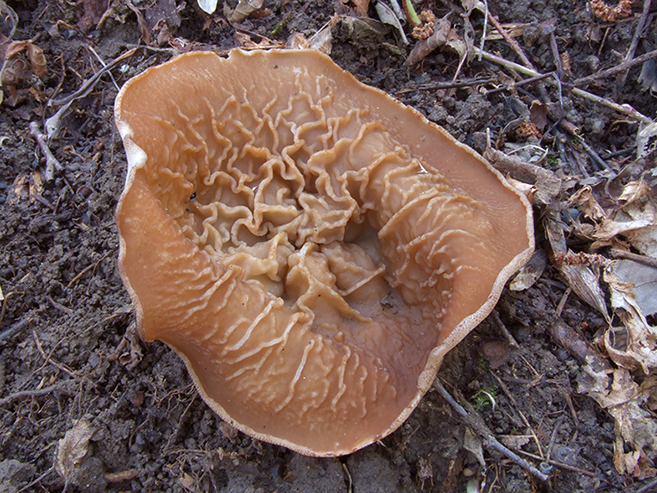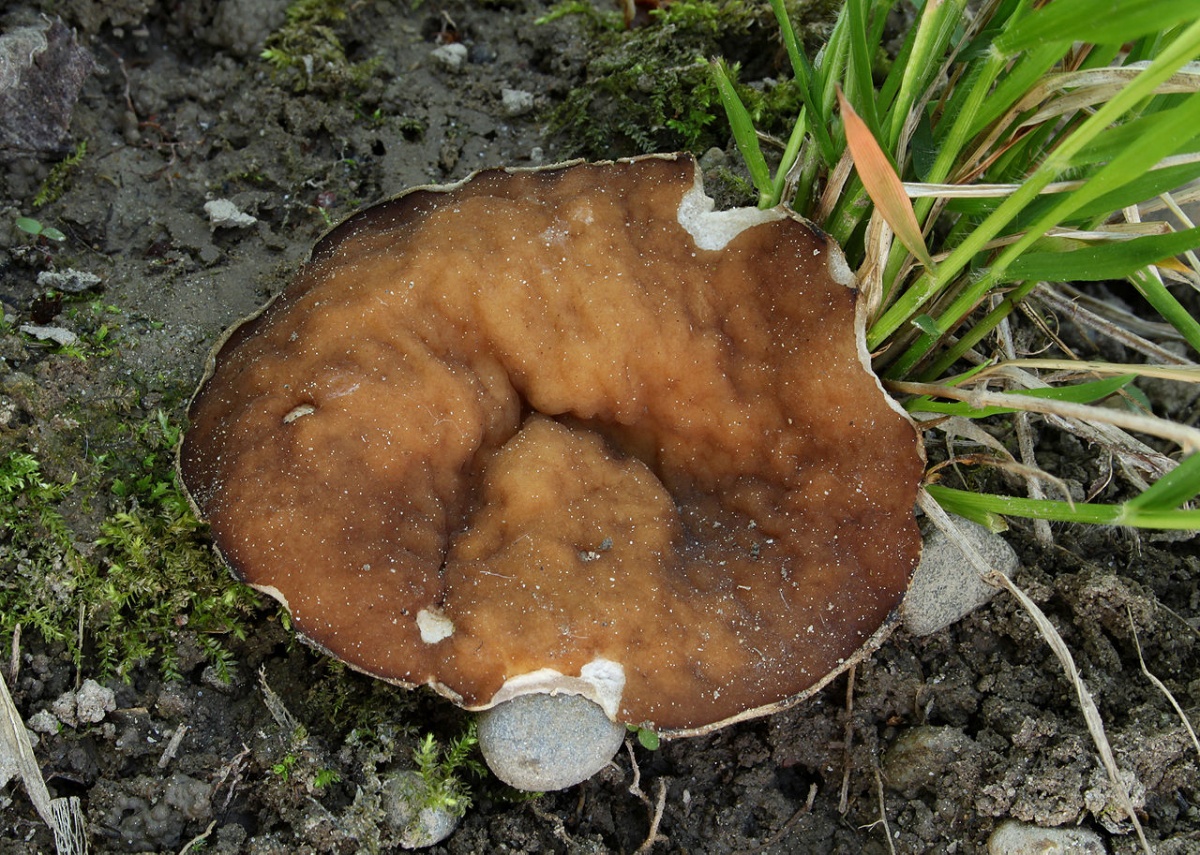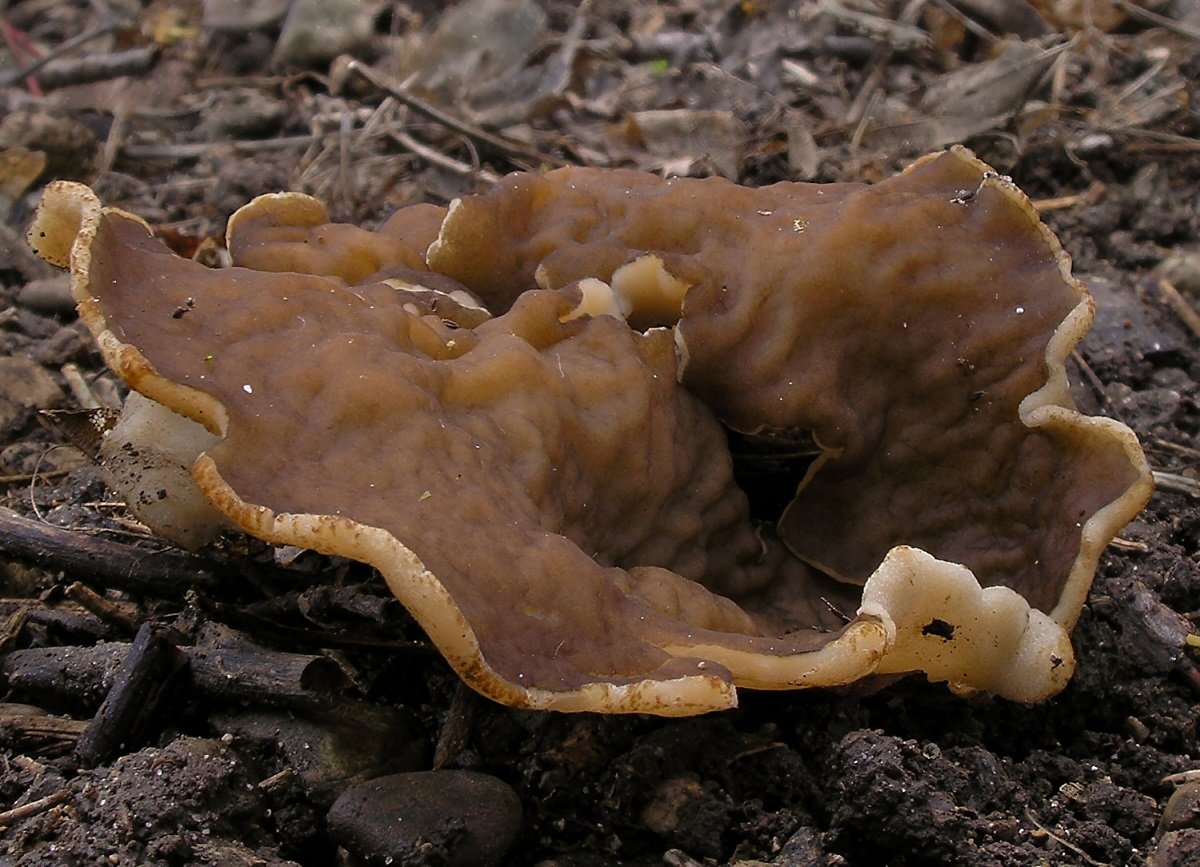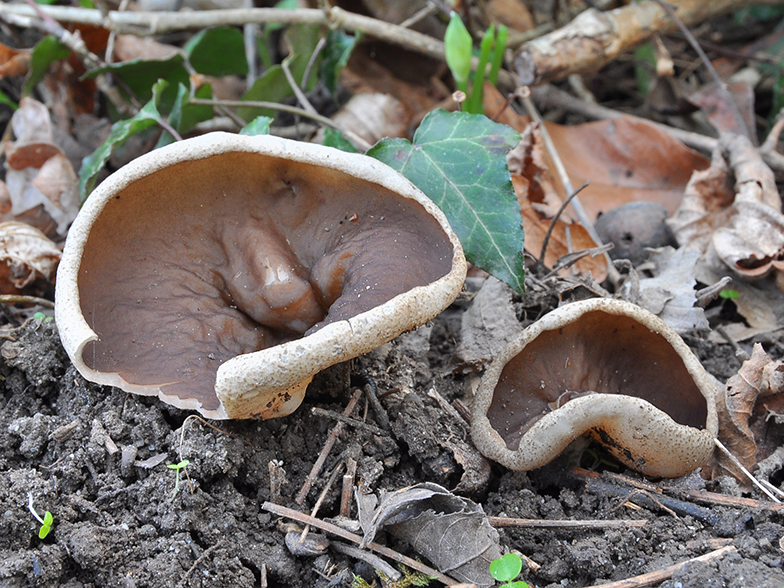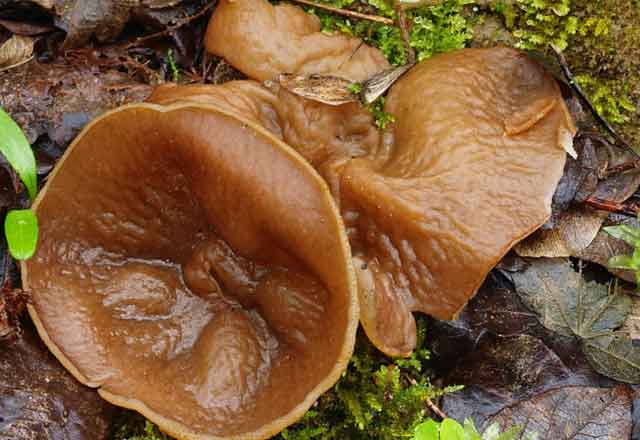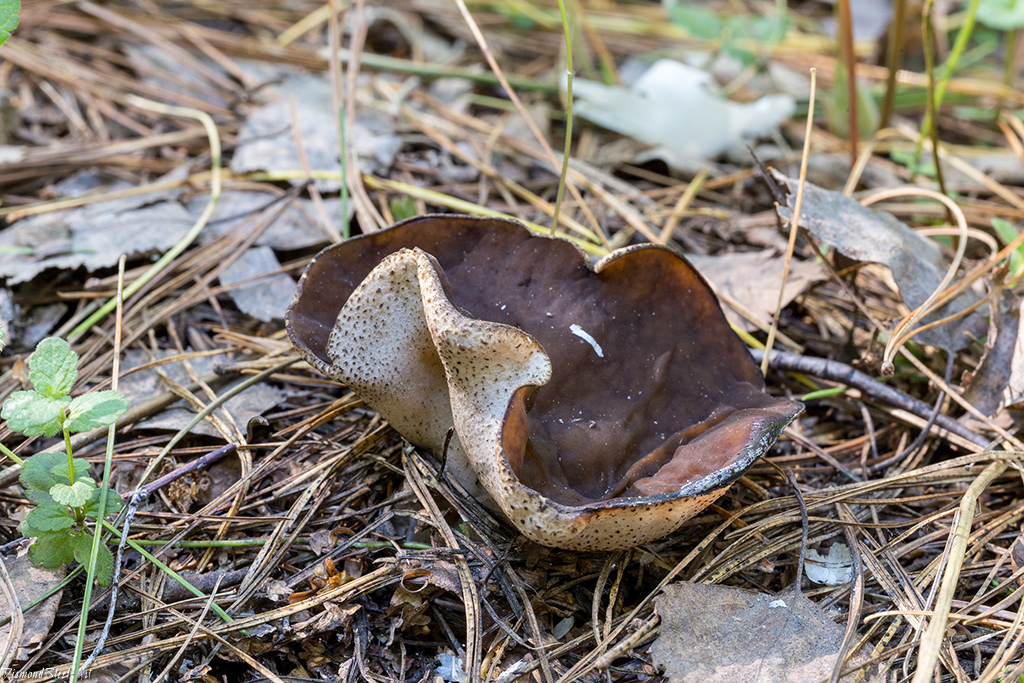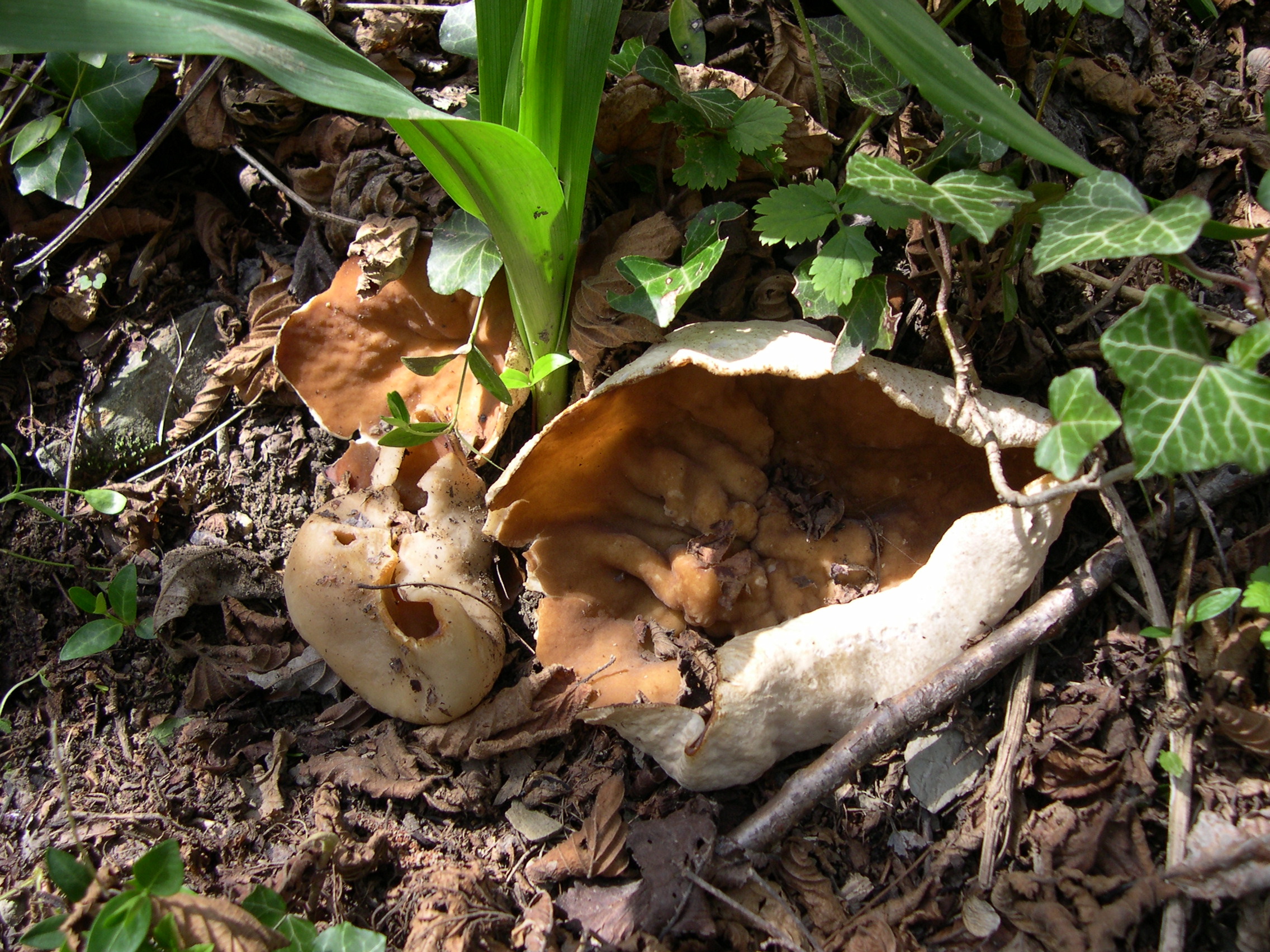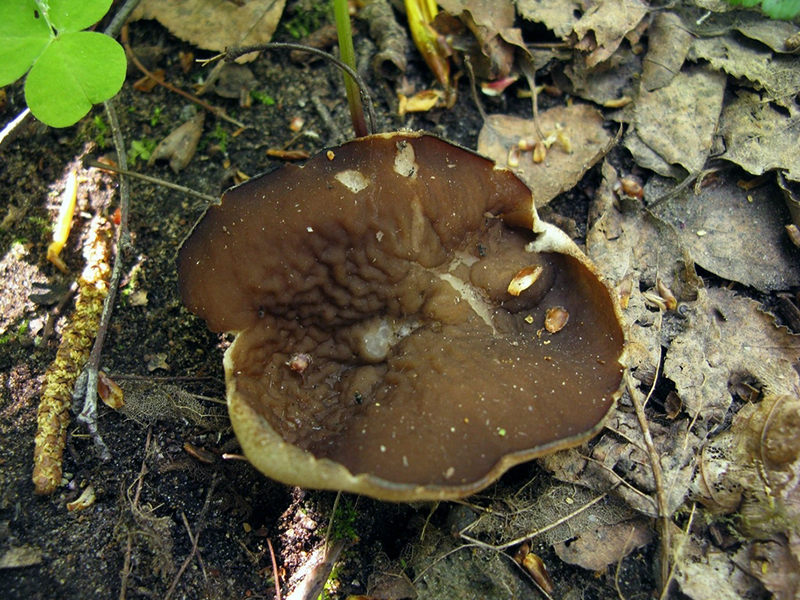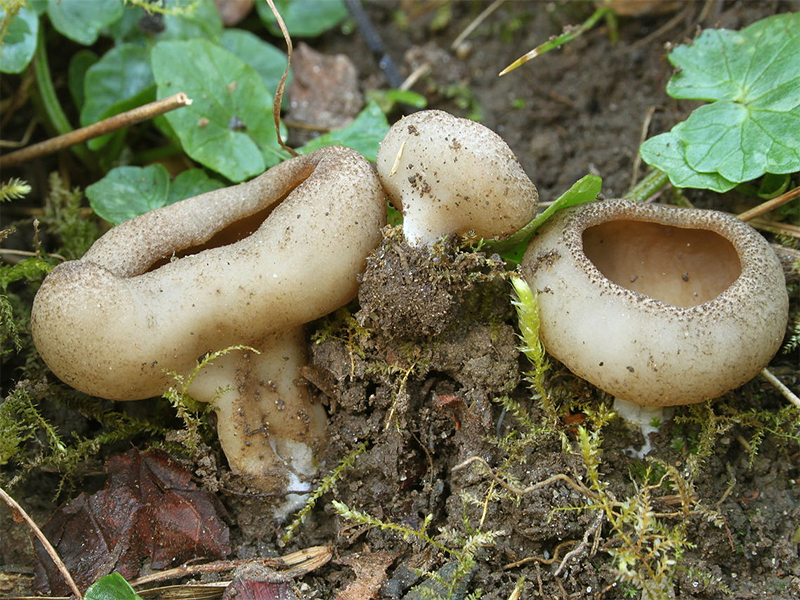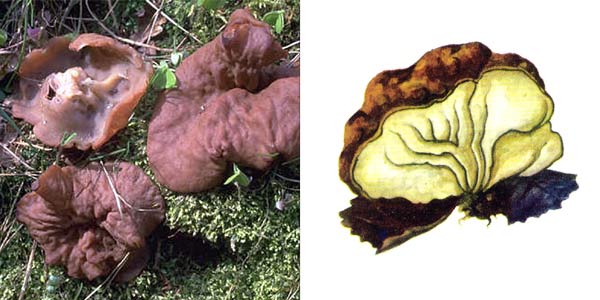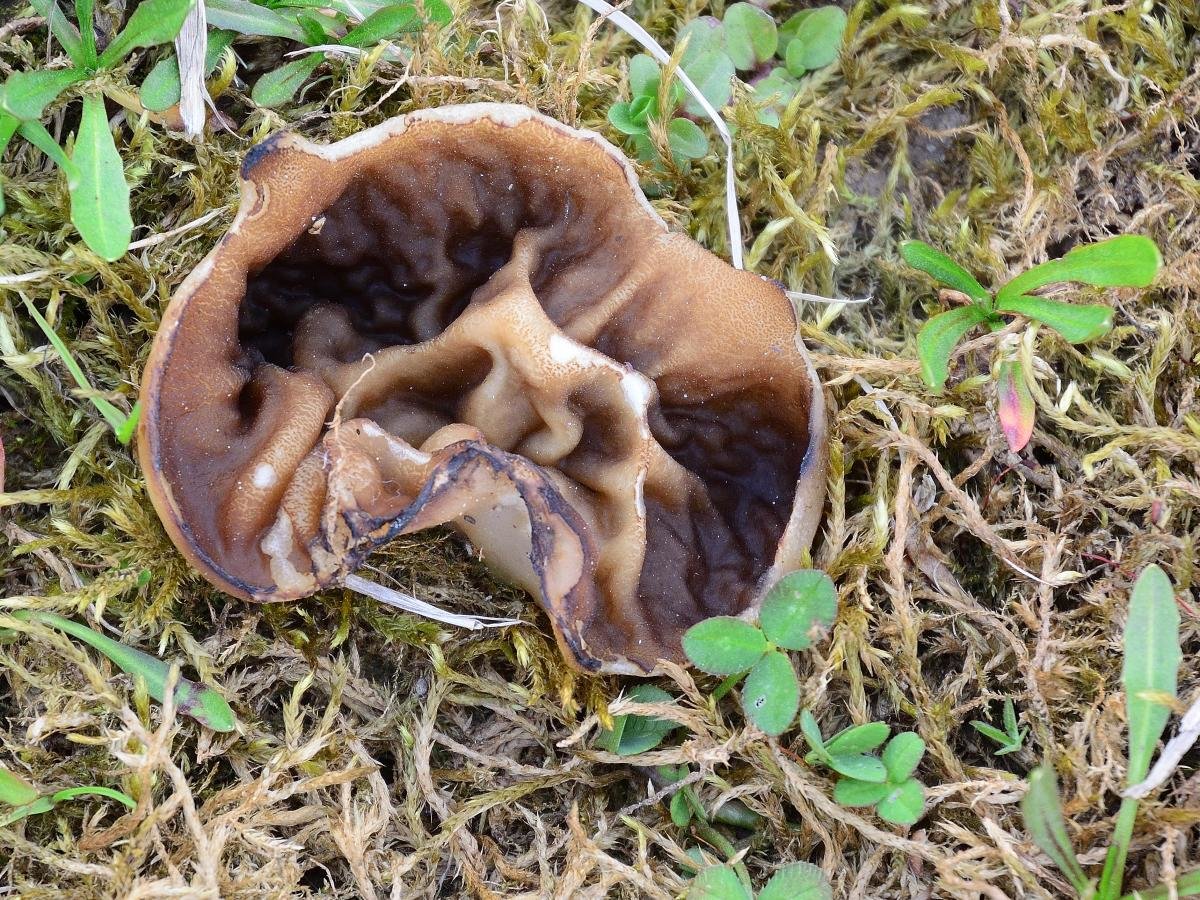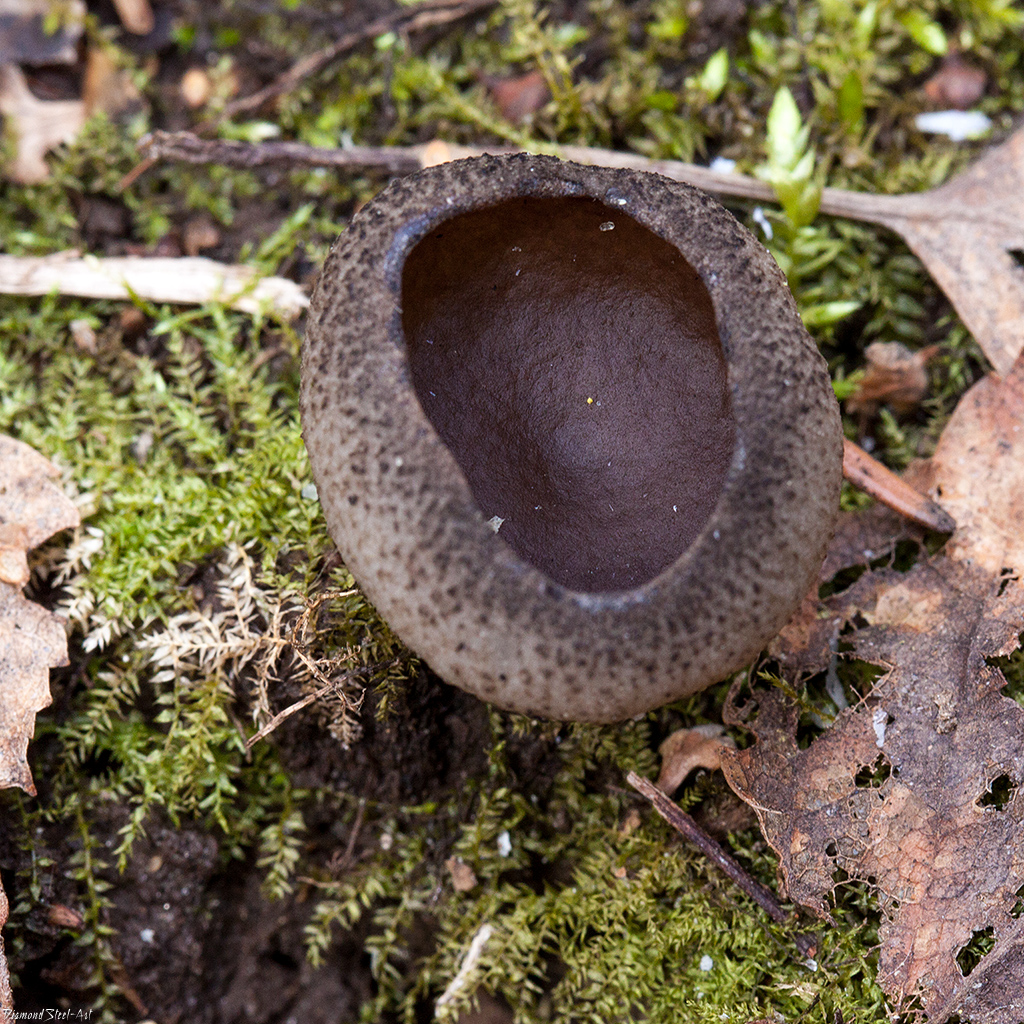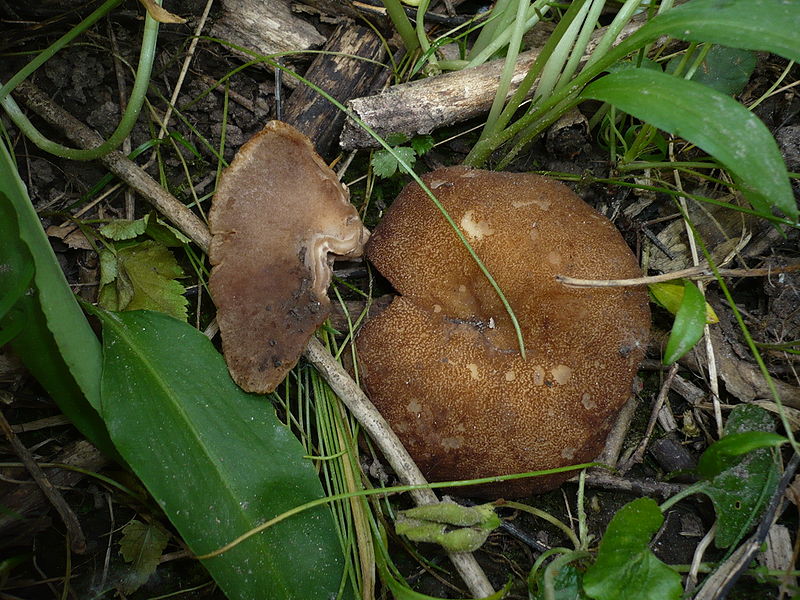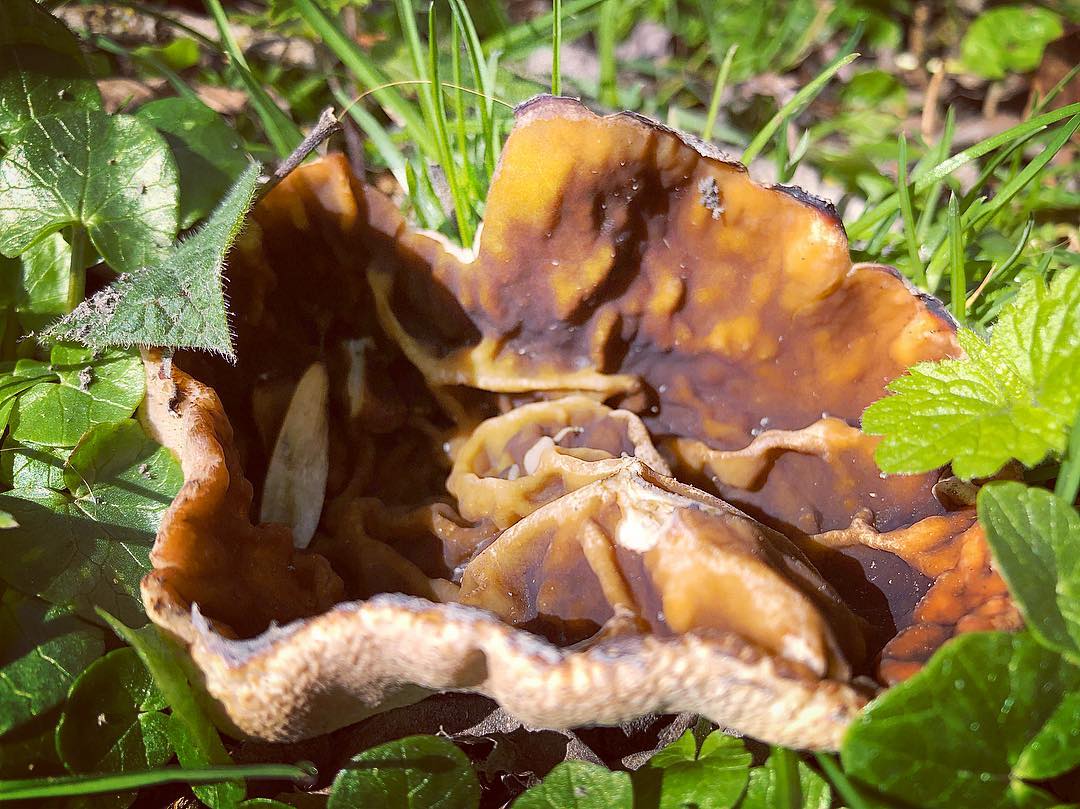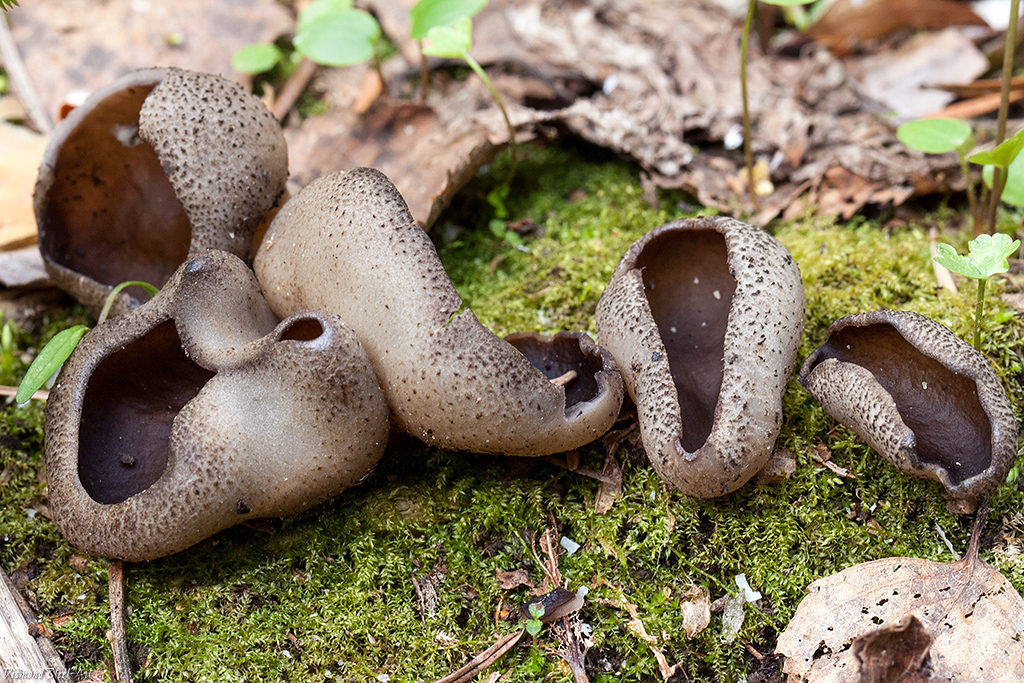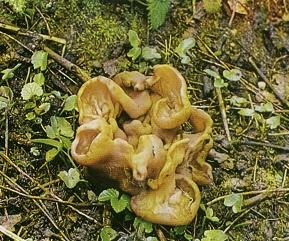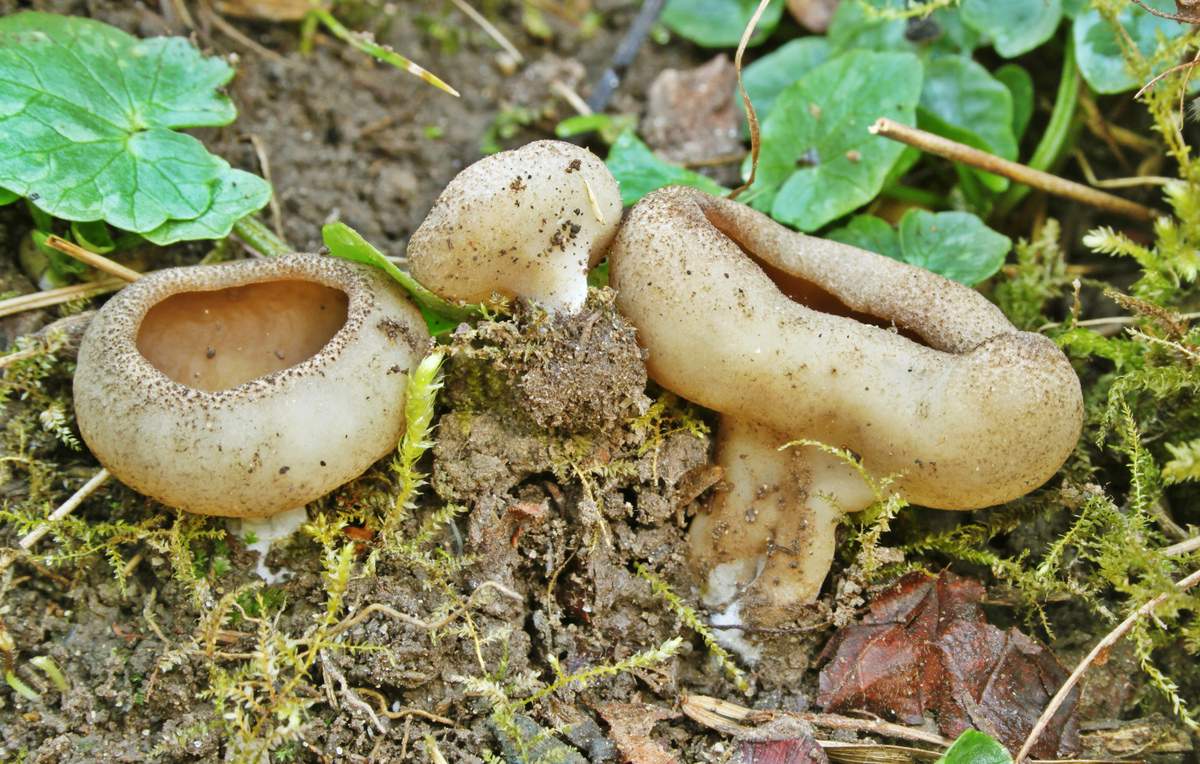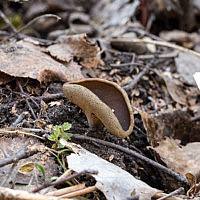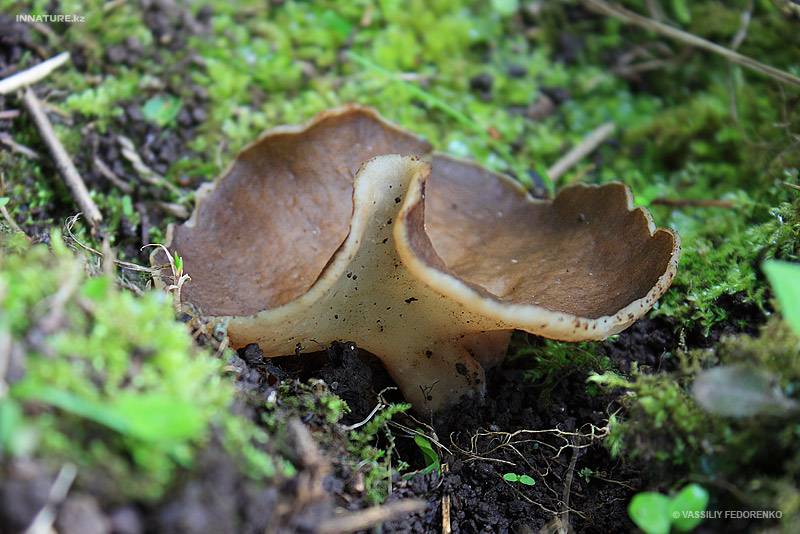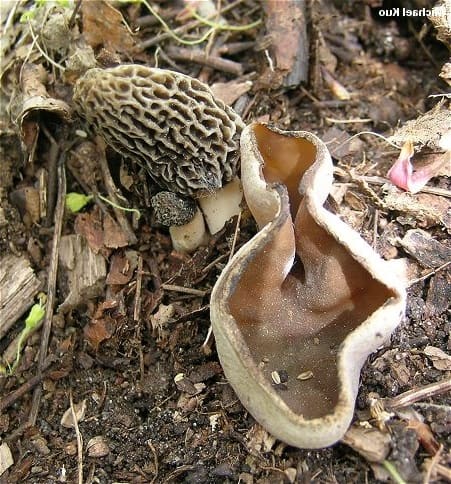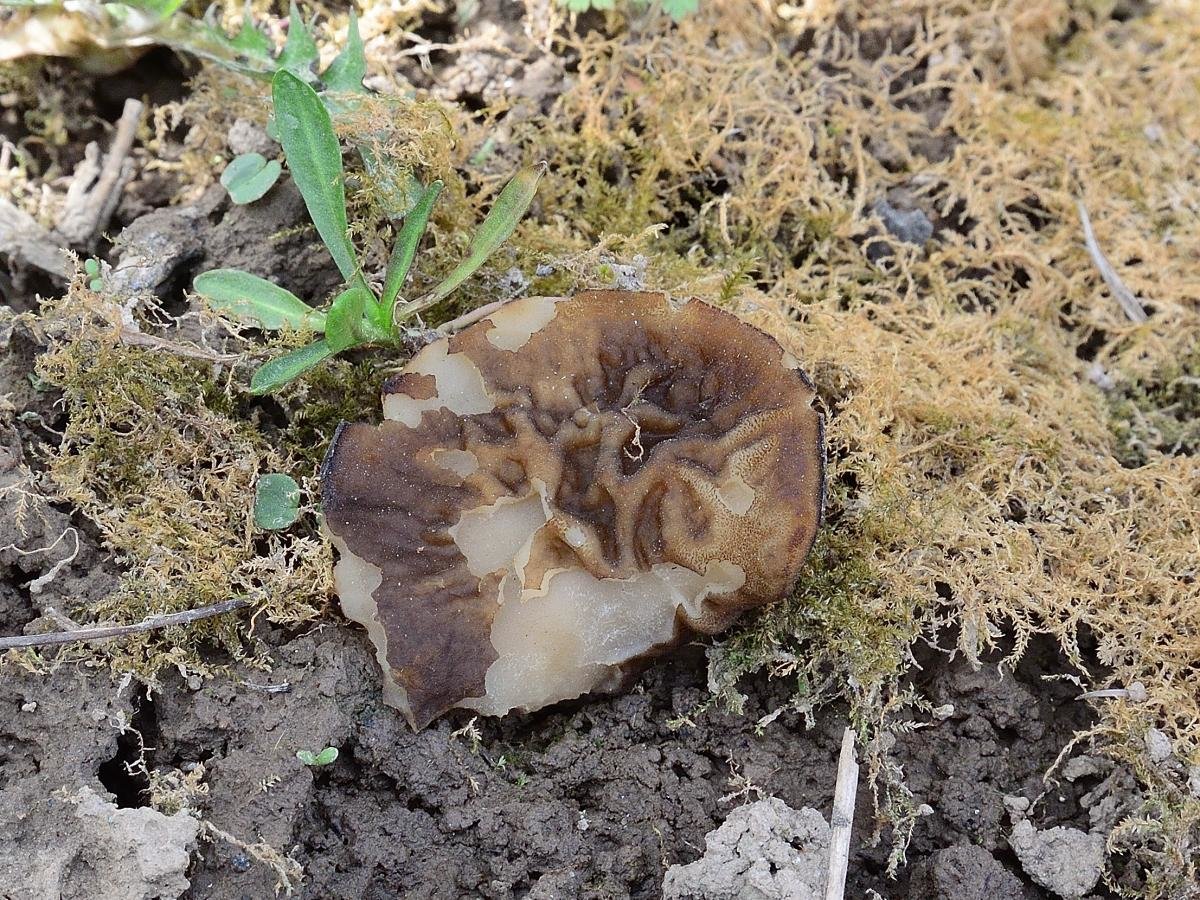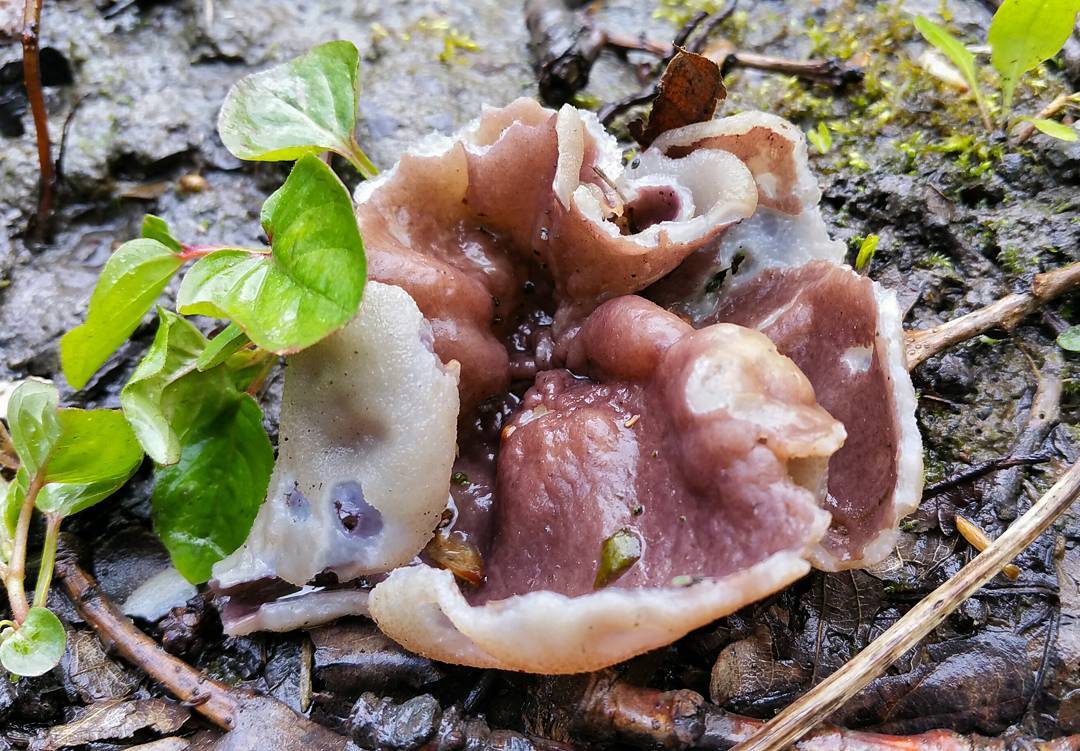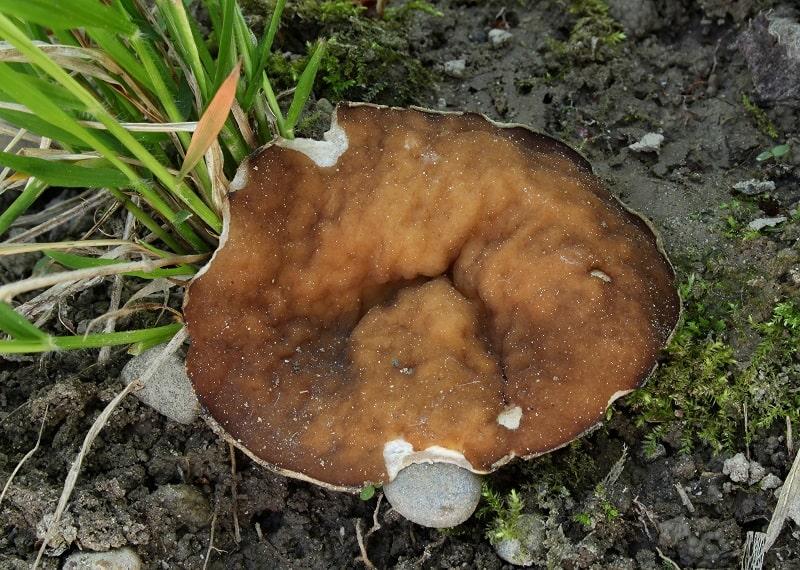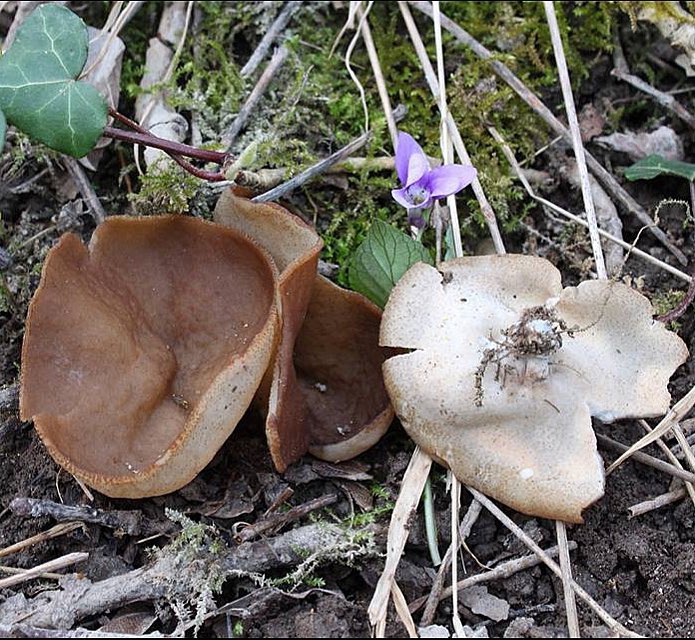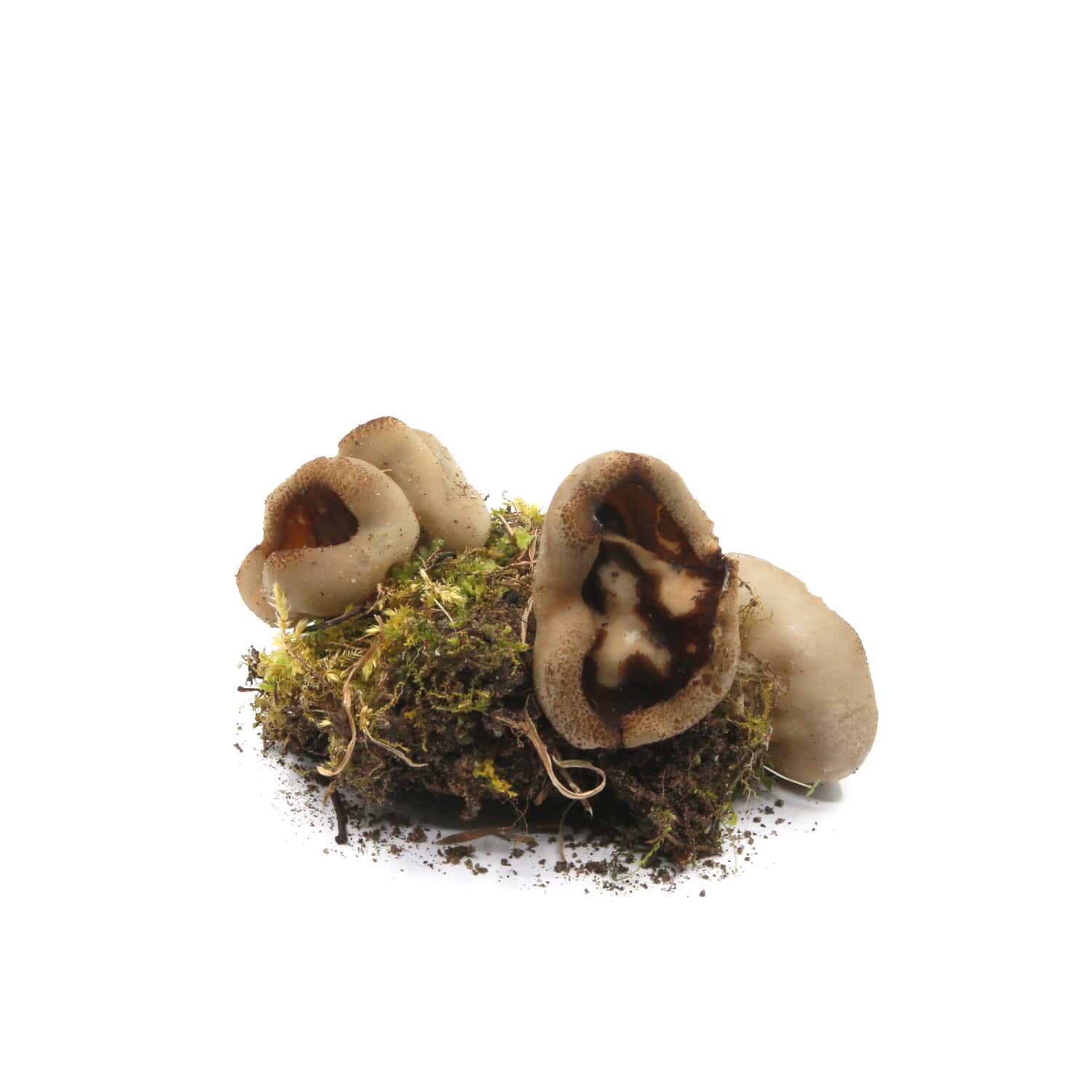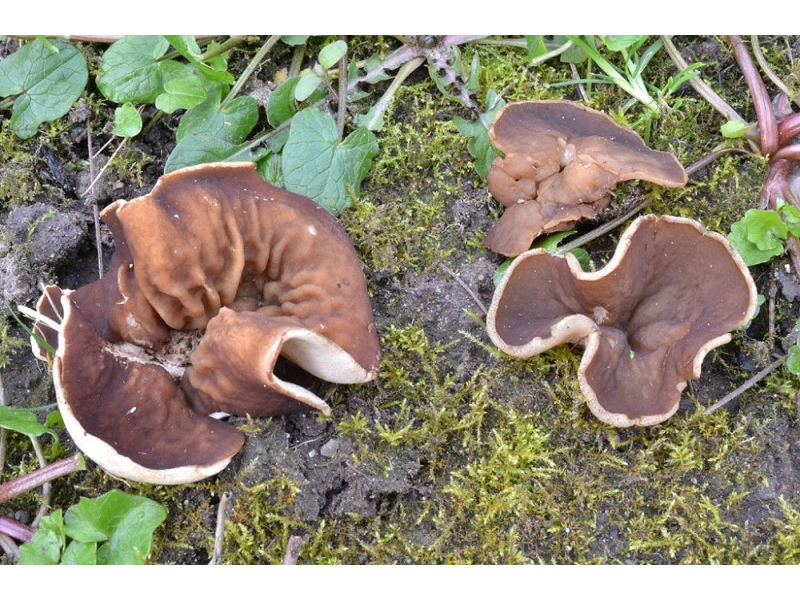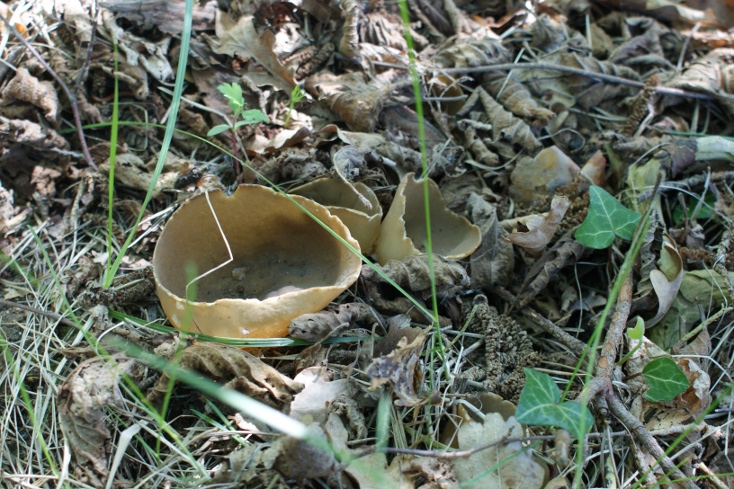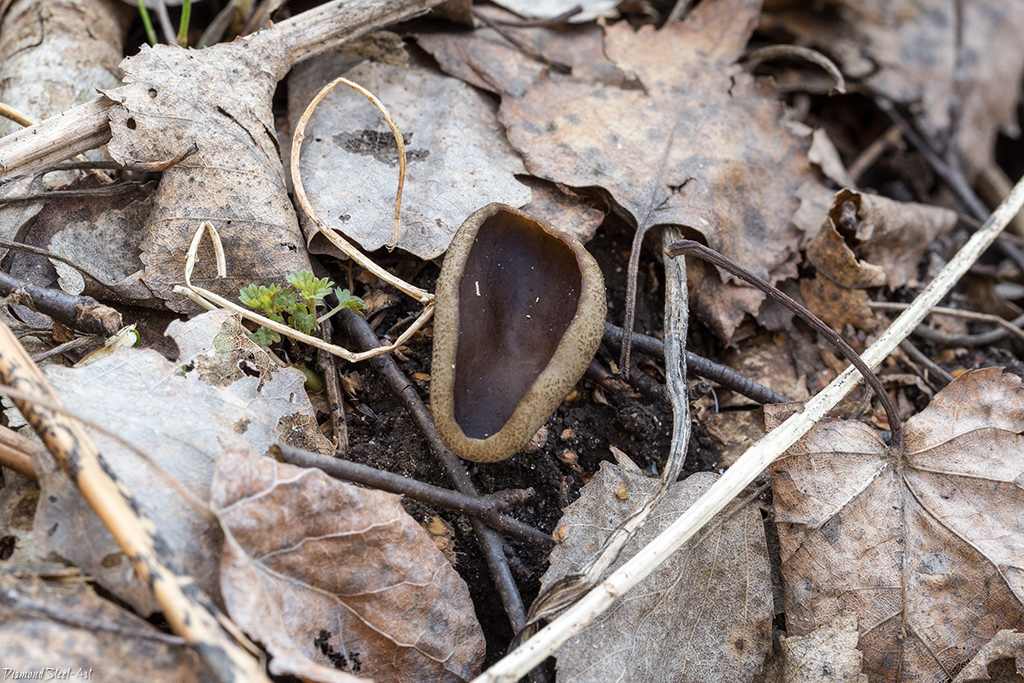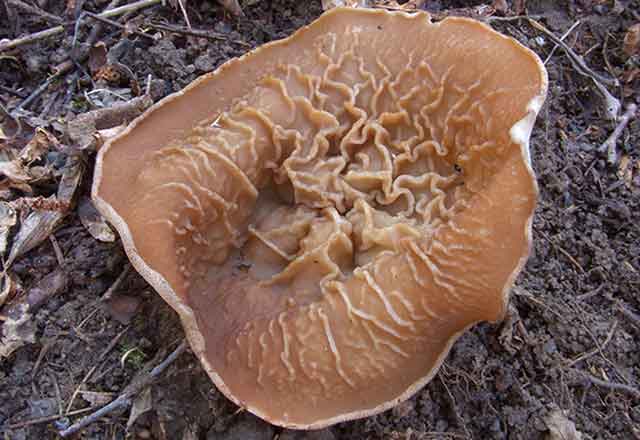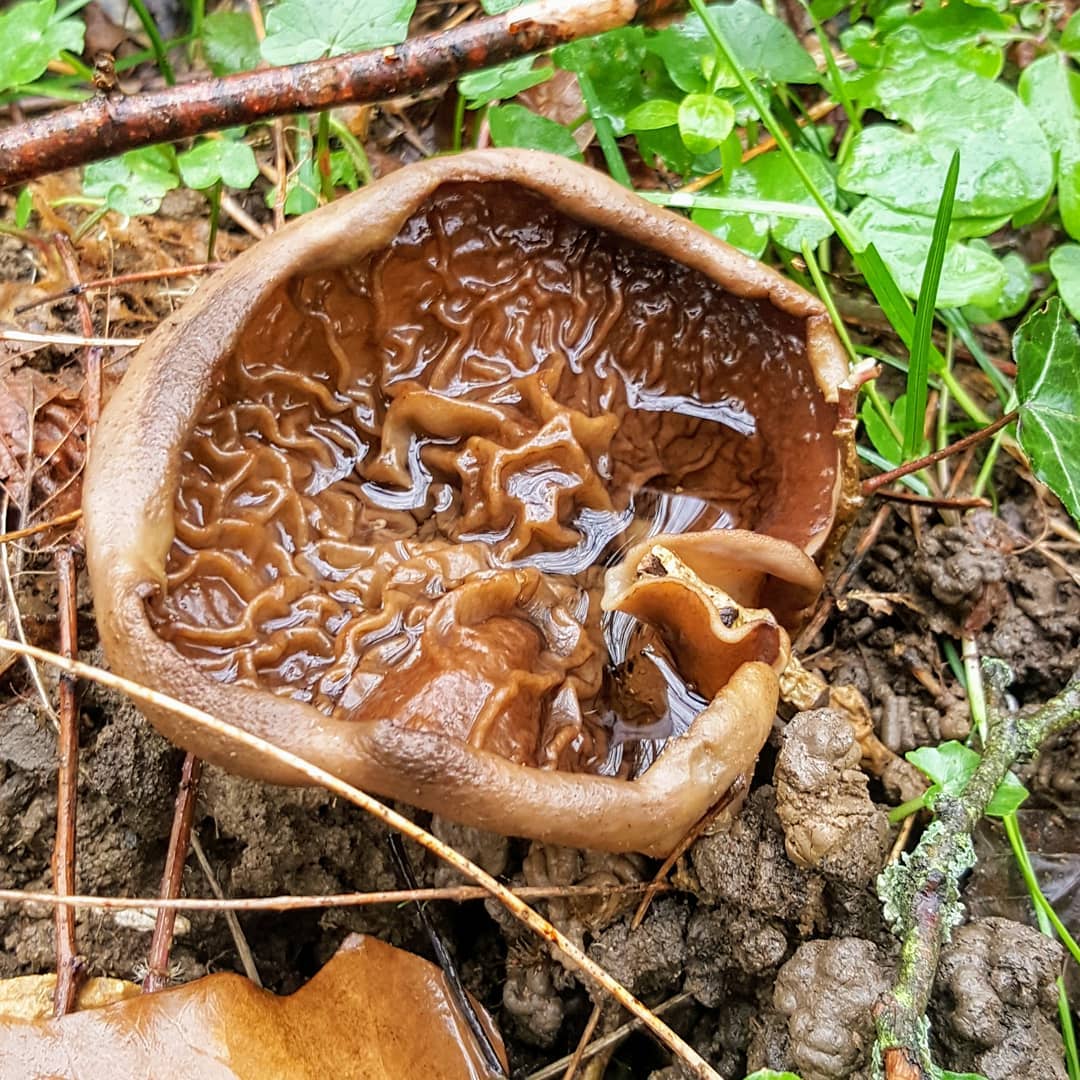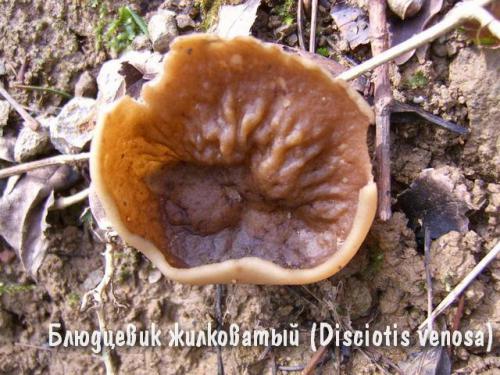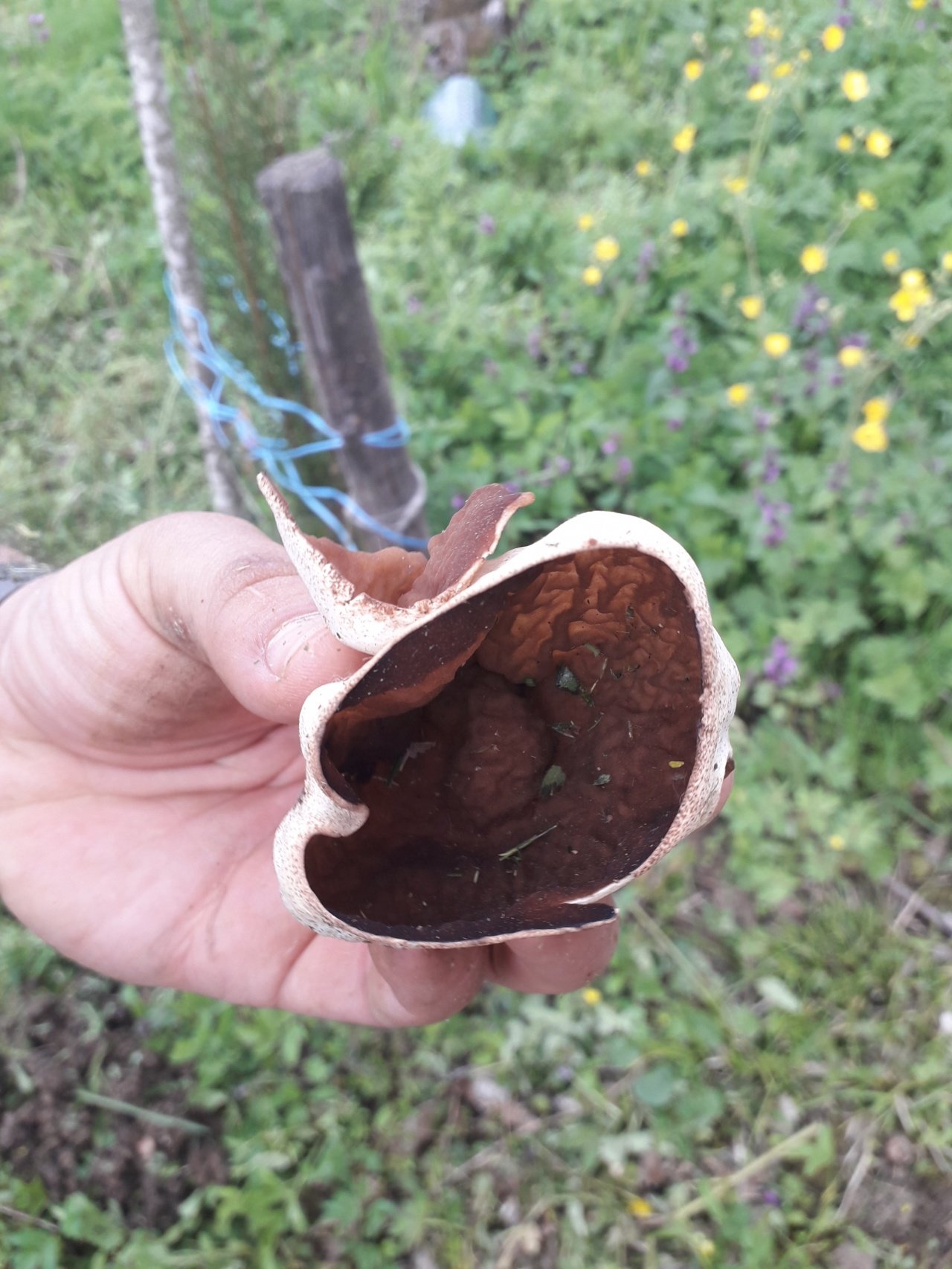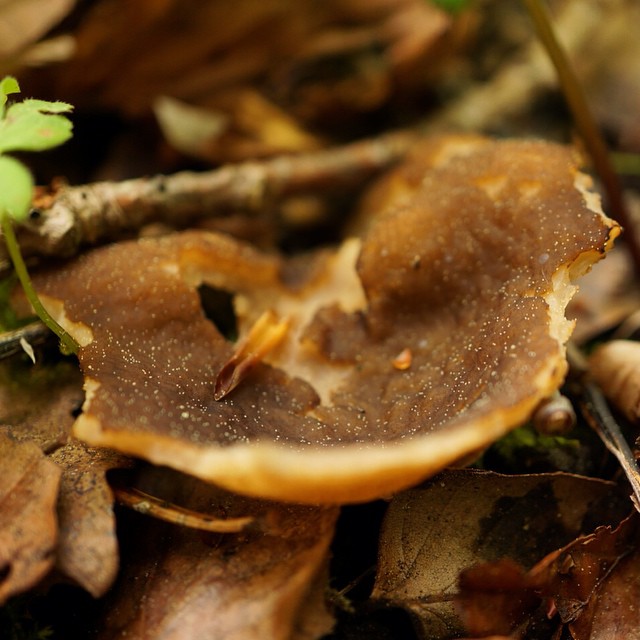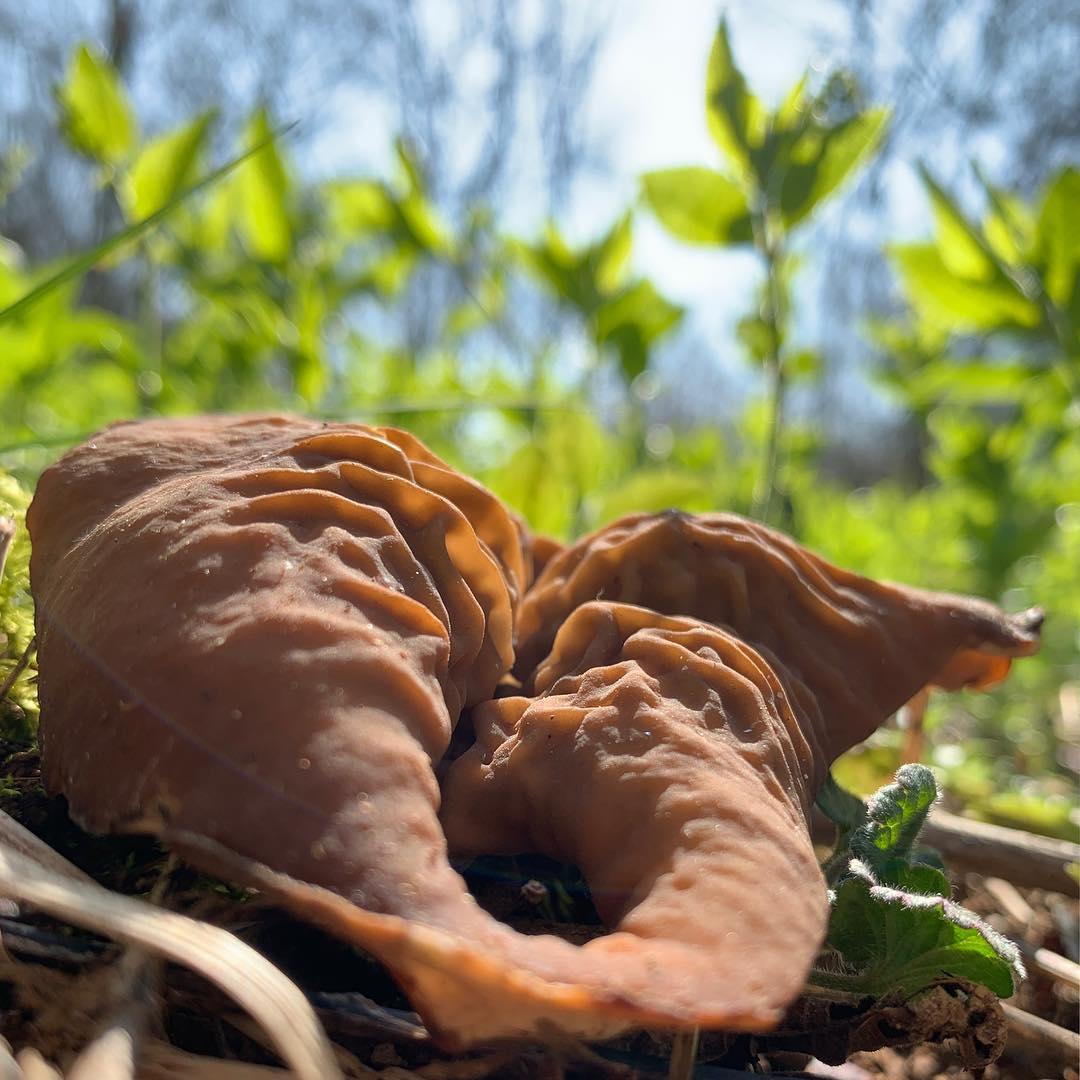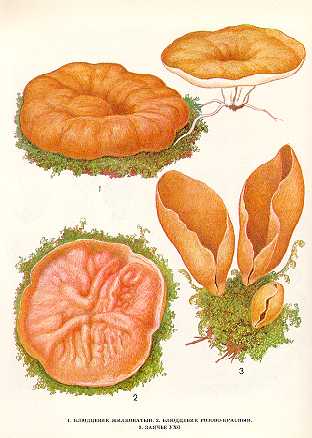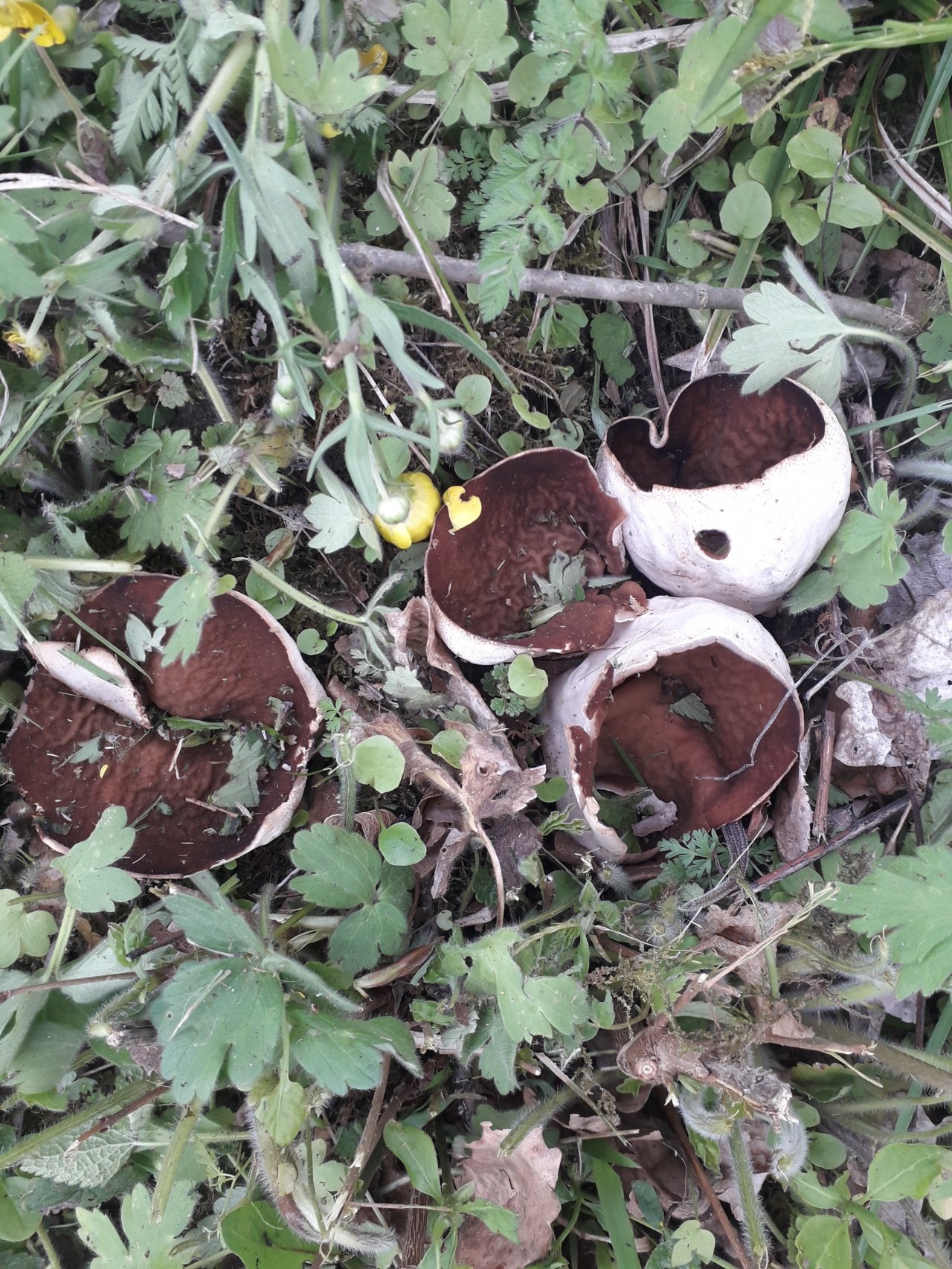Similar species
Thyroid dyscina has quite a few similar types:
It looks the same, slightly different only in microscopic signs of spores. Grows in mountain forests.
Has a greenish tint, grows directly near melting snow.
It grows only on beech wood.
 1-Discina earthen 2-Discina martinii
1-Discina earthen 2-Discina martinii
Grows on Mediterranean pines, is distinguished by microscopic characteristics of spores, which, moreover, are even more significant in size.
It has smaller spores and a yellowish fruiting body.
Has a yellowish hymenophore, larger spores, growing in the mountainous southern regions.
Has spines and a mesh on the surface of the spores. It grows not in coniferous, but in deciduous forests.
The hymenophore of this type of mushroom is black, and the sterile surface is white, the spores are smaller.
It grows on spruce needles and has a pinkish sterile surface and spines on the surface of the spores.
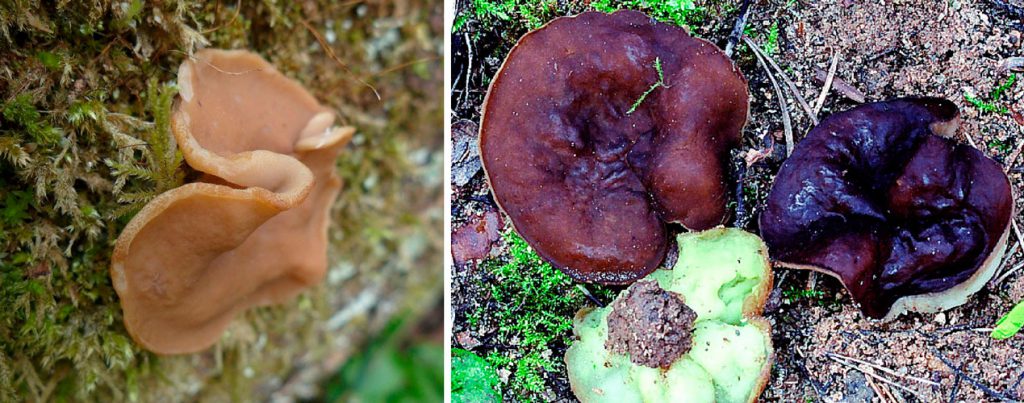 1-Discina-shield 2-Discina black and white
1-Discina-shield 2-Discina black and white
It differs in that it grows on soil and reaches a larger size, moreover, it smells of chlorine.
It is a species related to dyscine. It, in contrast to the above conditionally edible mushrooms, is poisonous due to the content of gyromitrin in it.
 1-Venous discina 2-Ordinary lines
1-Venous discina 2-Ordinary lines
Description
Thyroid dyscina is a marsupial discomycete mushroom, has a saucer-like structure.
Hat
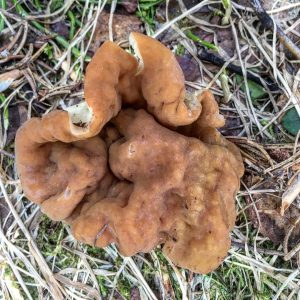 The division of the fruiting body into a cap and a stem in these mushrooms is rather arbitrary. In the cap, the upper surface is distinguished, on which the wrinkled layer of the hymenophore is located. In young specimens, it has shades of ocher, red and brown, and in mature specimens it is closer to black. The lower surface is sterile, it is almost smooth, in young specimens it is covered with fluff, sparsely ribbed starting from the stalk. Its color is white, yellow or reddish. The young fruiting body at first resembles a bud, then opens up to a "saucer", with ripening the saucer turns into a flat disc with uneven edges. The transverse size of the disc is up to 15 cm.
The division of the fruiting body into a cap and a stem in these mushrooms is rather arbitrary. In the cap, the upper surface is distinguished, on which the wrinkled layer of the hymenophore is located. In young specimens, it has shades of ocher, red and brown, and in mature specimens it is closer to black. The lower surface is sterile, it is almost smooth, in young specimens it is covered with fluff, sparsely ribbed starting from the stalk. Its color is white, yellow or reddish. The young fruiting body at first resembles a bud, then opens up to a "saucer", with ripening the saucer turns into a flat disc with uneven edges. The transverse size of the disc is up to 15 cm.
Leg
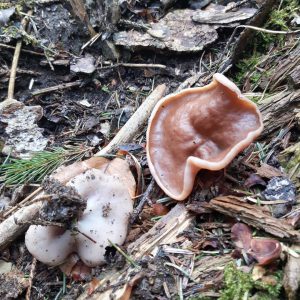 There is a pseudopod (continuation of the fruiting body). It is ribbed and thick (about 4 * 3 cm), sits deep in the substrate, sometimes it is completely reduced. Its color is similar to that of a sterile surface.
There is a pseudopod (continuation of the fruiting body). It is ribbed and thick (about 4 * 3 cm), sits deep in the substrate, sometimes it is completely reduced. Its color is similar to that of a sterile surface.
Pulp
Has a high density and increased fragility. Its color is from white to brownish gray. The smell and taste are pleasant mushroom, but not pronounced.
Veinous saucer (Disciotis venosa)
Current title
| Index Fungorum | Disciotis venosa (Pers.) Arnould | |
| MycoBank | Disciotis venosa (Persoon) Boudier |
Systematic position
Etymology of the species epithet
Vēnōsus, a, um 1) rich in blood vessels; 2) veined, venous. From vēna ae f 1) Vienna; blood vessel, vein; 2) pulse; 3) vein (wood, sheet, marble); water vein, underground jet; channel; it's time; urethra; intestine; ore vein; 4) metal, rock + -ōsus, a, um gain.
Synonyms
- Peziza venosa Pers., Syn. meth. fung. (Göttingen) 2: 638 (1801)
- Discina venosa (Pers.) Fr., Syst. mycol. (Lundae) 2 (1): 46 (1822)
- Discina reticulata (Grev.) Fr., Syst. mycol. (Lundae) 2 (1): 46 (1822)
- Peziza reticulata Grev., Scott. crypt. fl. (Edinburgh): pl. 156 (1825)
Other names: Venous dyscina, Veinous saucer.
Early spring (nival) species, appears simultaneously with other spring ascomycetes. Fruiting cannot be called massive - usually it is one or two finds per season for collecting morels and morels. In principle, the saucer can be confused with Helwells - Helvella acetabulum and Helvella queletii, in which the outer, sterile surface is smooth, and the leg with a more pronounced relief, and with the thyroid discina Discina ancilis, which differs on average in a larger size, a warmer shade of brown and found on sandy soil in forests (disciotis, as a rule, grows in deciduous and mixed forests on moist, fertile soil).
Habit
Fruit body: Cup-shaped, saucer-shaped, in the form of ears (discomycetes)
Hymenophore: Smooth, not pronounced
Fruiting body
Fruiting bodies (30) 50 - 150 (200) mm in diameter, at a young age cupped with an inward-turned edge, when ripe they open to prostrate.The upper, spore-bearing, surface is reddish-brown, brown, dark brown, may be with a violet tinge, at first smooth, then radially wrinkled, with veins, sometimes as if covered with a venous network; lower, sterile, surface light, whitish, yellowish, rough, with white bloom and small dark spots, wrinkles downwards into a short folded leg. The edge is wavy, often torn in several places.
Pulp
The pulp is rather thick, brittle, with a chlorine smell.
Microscopy
Spores 19 - 23 (25) × 12 - 13 (15) µm, wide ellipsoid, smooth, transparent.
Bags 300 - 350 × 17 - 23 μm, 8-spore.
Paraphyses with septa, sometimes branching, with brown content, expanded at the ends to 6-10 microns.
Ecology and distribution
Substrate: Soil, litter
Grows singly and in small groups on fertile soil in deciduous, coniferous and mixed forests.
Doubles and their differences
A characteristic feature of the veinous saucer is the accompanying strong chlorine smell, making it almost impossible to confuse this species with any other. Nevertheless, the mushroom has an external similarity with at least two species.
Pecica
Its fruiting body also consists of a cupped apothecia, reaching up to 10 cm in diameter. The color can be the same, but the difference in size will definitely favor the saucer. In addition, the shape of the outer edge of the apothecia in pecitsa has a characteristic detail - it almost always curls much inward. The saucer can also have edges bent outward.
Typical type of fruit body of Pecica: strongly deformed apothecia with inwardly curved edges
Almost all petsitsa - conditionally edible mushrooms, as well as saucers. You can eat them, but the taste leaves much to be desired.
Lines
It is possible to confuse with the line only the large and adult fruiting bodies of the saucers, which are significantly deformed and become too dark in color. But the likelihood of this is extremely small - it is very problematic to find such a strongly altered disciotis.
The classic stitching has a cap diameter of about 13 cm, which is already significantly smaller than adult and even highly compressed saucers. The leg of this mushroom is up to 9 cm long and up to 4 cm in diameter. The cap is covered with characteristic folds that are difficult to confuse with any other mushroom.
The periods of fruiting also differ in the compared species: the line can be found in the forest from March to May. In addition, this species has a pleasant mushroom smell.
The leg of the double can be long
You should be especially careful not to accidentally confuse the morel with a veinous saucer.
Saucer vein mushroom: description, photo, how to cook
Veinous saucer (Disciotis venosa)
- Veinous saucer (Disciotis Venosa);
- Family: Morels (Morchellaceae);
- Other names of the fungus: venous discina;
- Edible, main use in cooking: frying and drying (nutritional category 4).
The veinous saucer belongs to the genus of marsupial mushrooms and belongs to the Morechkov family. Its fruiting body is in the shape of a cup, which looks like a round saucer. That is why he got such a name.
The venous saucer is also called the venous discina. The diameter of his cap reaches 20 cm. Its edges are concave inward, and the surface is smooth, but becomes wrinkled with age. The color of the cap changes from yellow to brown.
The stem of the mushroom is very short. It has a white color and is almost invisible due to the fact that it is completely buried in the ground.
Veinous saucer has a white spore powder and very fragile grayish flesh. Its main difference is the characteristic smell of chlorine.
Saucers are formed as a result of the reproductive process of the bags, which are unicellular structures. Such mushrooms are a source of vitamins, fodder protein and can be used as a causative agent of alcoholic fermentation.Today they are actively used as objects of biochemical research.
Fruiting period: April to June
Harm and contraindications
The possible harm to saucers is due to the same chemical composition. Chitin is difficult to digest in the stomach and interferes with the absorption of other nutrients. There is more of it in mushroom legs than in hats.
Do not use saucers for people who have the following health problems:
- liver diseases;
- kidney disease;
- pathology of the gastrointestinal tract.
It is forbidden to use saucers for children, nursing and pregnant women. Too many mushrooms in the diet can provoke inflammation of the pancreas, complications in the gastrointestinal tract, pancreatitis. Saucers are useful only in moderation, even for healthy people. Nutritionists recommend eating them no more than 2 times a week.
Before going for saucers, it is recommended to carefully study the relevant literature in order to know what a particular specimen looks like and to be able to distinguish edible mushrooms from poisonous ones.
Ignorance of the types of mushrooms can lead to poisoning and even fatal consequences.
Due to their unique composition, saucers can not only diversify the daily menu, but also help to heal the body and cope with chronic diseases. True, most mushroom pickers prefer to leave beautiful saucers as a decoration for our forests.
Description of the venous saucer
The fruiting body of the venous saucer consists of a kind of basket - the so-called "apothecia", having a diameter of 3 to 21 cm, with a short and rather thick leg. Young specimens have a round shape with edges curved inward.
Fruit bodies of young veinous saucer
With age, the cap straightens out, becoming like a bowl, and then it can generally become prostrate with torn edges. The hymenophore is located on the outer surface. At first it is smooth, later it is lumpy.
A characteristic feature of this species is the strong smell of bleach emitted by adult specimens. The color can be from yellowish gray to deep brown. A veinous saucer is shown in the photo below:
Fruit body of an adult mushroom
Mushrooms of an unusual shape from the Morel family
High morel (Morchella elata).
Family: Morels (Morchellaceae).
Season: April - June.
Growth: singly and in small groups.
Description:
The pulp is white, tender, hollow inside, with an earthy or mushroom odor. The cells are olive brown, in mature mushrooms they are brown or black-brown.
The cap is narrow, conical, covered with cells, bounded by more or less parallel vertical narrow folds. The edge of the cap at a young age extends beyond the border of the connection with the pedicle, smoothes over time, smoothly passes into the pedicle.
The leg is folded, widened at the base, hollow, whitish in young mushrooms, later yellowish or ocher. the color of the fungus darkens with age.
Conditionally edible mushroom. Suitable for food after boiling for 10-15 minutes (the broth is drained), or after drying for 30-40 days.
Ecology and distribution:
It grows on soil in coniferous and deciduous forests, often in grassy meadows and forest edges, in gardens and vegetable gardens.
Real morel (Morchella esculenta).
Family: Morels (Morchellaceae).
Season: early May - mid June.
Growth: singly and in groups.
Description:
The leg grows together with the edge of the cap.
The mushroom is hollow inside. The cap is rounded, brown, coarsely meshed.
The pulp is waxy, brittle, with a pleasant groin and taste. The leg is whitish or yellowish, widened at the bottom, often notched.
Delicious conditionally edible mushroom. Suitable for food after boiling for 10-15 minutes (the broth is drained), or dried.
Ecology and distribution:
It grows in light deciduous, as well as mixed and coniferous forests, in parks and gardens, on grassy lawns and forest edges, under bushes, in clearings.
Conical cap (Verpa conica).
Family: Morels (Morchellaceae).
Season: April - May.
Growth: singly and in scattered groups.
Description:
The leg is cylindrical or laterally flattened, hollow, brittle, covered with pityriasis scales; the color is white, then turns yellow.
The cap is bell-conical, brown tones.
The flesh is tender, fragile. The surface of the cap is covered with shallow wrinkles, sometimes almost smooth, crumpled, usually present at the top.
Ecology and distribution:
Grows in deciduous, mixed and floodplain forests, shrubs, forest belts, more often next to aspens, willows, birches. It is rare.
Veinous saucer (Disciotis venosa).
Family: Morels (Morchellaceae).
Season: April - May.
Growth: singly or in small groups.
Description:
The outer surface is smooth, mealy or finely flaked, folded, whitish or buffy.
The pulp is brittle, with a mild taste and smell of chlorine. The inner surface is at first smooth, ocher, then becomes radially ribbed, brown.
The fruit body is fleshy, first cupped or saucer-shaped, then flat.
The short stem is submerged in the soil.
Poor quality edible mushroom. Requires pre-cooking to remove unpleasant odors.
Ecology and distribution:
It grows on sandy soil in forests of various types, along roads, ravines, along stream banks, in clearings.
The benefits of vein saucers
Despite the relative culinary neutrality of the fungus, it can be used for medicinal and prophylactic purposes. The beneficial properties of the venous saucer are due to its composition. This mushroom contains glucan and chitin, which can lower blood cholesterol levels. Consuming these substances is believed to support the functioning of the immune system and improve resistance to stress.
In addition, the venous saucer includes:
- dietary fiber (helps cleanse the intestines);
- B vitamins (improving metabolism, carbohydrate synthesis, erythrocyte regeneration, etc.);
- vitamin C (antioxidant, normalizer of metabolic processes);
- ash and other minerals.
The beneficial properties of the venous saucer are also due to the riboflavin it contains (improving vision and the functioning of the nervous system) and niacin, which regulates the functioning of the pancreas.
Vein Saucer - Disciotis venosa
| vein saucer | |
|---|---|
| Scientific classification | |
| Kingdom: | |
| Class: | |
| Binomial name | |
| vein saucer | |
| Synonyms | |
|
Veinous saucer commonly known as bleach cup , sinewy mushroom cups , or Morel cup is a type of mushroom in the morel family. Fruiting in April and May, they are often difficult to spot due to their indeterminate brown color. Found in North America and Europe, they appear in favor of banks and slopes and secure sites. Though D. Venosa Considered edible, it may resemble several other types of brown cups of mushrooms of unknown edibility.
How to cook
Mushrooms of this genus are conditionally edible and belong to the fourth category in terms of nutritional value. The venous saucer is not very popular due to its mediocre taste and not too pleasant smell. It can be dried, fried, stewed.
Heat treatment is used to eliminate the unpleasant odor. It is necessary to boil the saucers for half an hour. The remaining mushroom broth cannot be eaten.
Such mushrooms should be dried for several months, carefully preparing the caps before drying. They are well peeled, cut into pieces and stored in a dark place.Dried mushrooms are mainly used for preparing first courses.
Saucers are not at all high in calories, so they can easily be used as part of dietary meals. Due to the lack of taste, many housewives prefer to use them as a decoration for salads.
Fried saucers
To prepare this dish you will need:
- 500 g saucers;
- 2 tablespoons of butter;
- lemon juice;
- pepper;
- salt.
Cooking method:
- The mushrooms need to be peeled, sliced and boiled in salted water.
- Then they are thrown into a colander and allowed to drain.
- Then fry until golden brown, sprinkled with lemon juice, salt and pepper.
To freeze saucers for the winter, you should first boil them in salted water. After they are dry, they are laid out on a tray and placed in the freezer. You can arrange the mushrooms in bags or containers. For freezing, you need to choose strong, young and whole specimens.
Description
Vein dyscina is a rare discomycete. It can be both a mycorrhizal forming agent and a saprotroph.
Hat
At a young age, it is a spherical apothecium with edges tucked inward. With maturation, the apothecia opens and takes the form of an uneven disc with tortuous or deformed edges. The size of the "ball" of a young apothecia can reach 10 cm in diameter, and the disc - 20 cm. The upper (inner) part of the "cap" is a hymenophore, and the outer part is sterile. The latter is pinkish-gray in color and has a mealy or scaly dry surface. The fungus hymenophore is brown or dark brown, wrinkled or veined.
Leg
It stands out conditionally: this is a continuation of the fruiting body, which is almost completely hidden in the substrate. The length of this formation is no more than 1.5 cm, the color is almost white.
Pulp
It is characterized by a rather high density and significant fragility. The flesh color is gray or brownish. It has no particular taste, but it smells strongly of chlorine. This smell is eliminated by heat treatment.
Aleuria orange
Orange aleuria is one of the most beautiful mushrooms with a very bright saturated color. It is simply impossible to pass by, leaving this mushroom unattended. The bright orange mushrooms grow in families, like living "moths" that appear on the surface in very early spring, as soon as the snow melts.
It is also worth noting the fact that many sources claim that orange aleuria is a completely inedible mushroom, although, according to many mushroom pickers, it is one of the most delicious. We will classify the mushroom as conditionally edible. The shape of the mushroom is also unusual. Its caps are similar to saucers, which sit on short legs, up to 5 cm in diameter. Moreover, the edges of the “plates” are slightly turned upward, which further enhances the “porcelain” visual effect. Often, these mushrooms grow together with their caps due to the fact that they grow too close.
The mushroom is most widespread in cold latitudes, and its favorite place of growth is injured soil, ditches, landslide edges. The mushroom appears in the middle of summer, and grows until the end. The most fertile orange aleuria in late August.
When and where to collect the veinous saucer
Veinous saucers are quite rare, and most mushroom pickers bypass them or collect with extreme reluctance. In the West, these mushrooms are considered inedible. However, after high-quality heat treatment, they are quite suitable for food. For their habitat, they choose damaged or sandy soils and often coexist with morels.
Veinous saucer usually grows in groups, less often singly. It is found in coniferous and mixed forests from May to June. Often mushrooms are located near decayed wood, they live near ravines and roads. They are not too conspicuous, so they require special care during a "quiet" hunt.
Inexperienced mushroom pickers can confuse venous discina with morel or ordinary line, which is deadly poisonous in its raw form.The saucer has no more inedible counterparts.
Some rules for collecting discina venous should be observed:
- It is not recommended to cut off overgrown specimens and those mushrooms that grow on highways and railways. Externally harmless species may contain toxic substances.
- It is better to take with you a convenient basket in which the saucers will not break. A collection bucket or bag is not suitable.
- It is not worth buying these mushrooms from the hands, they can be collected in contaminated areas.
Mushroom pickers advise to carefully cut off brittle fruiting bodies so as not to damage them, otherwise one dust can be brought home.
Taste qualities of the veinous saucer
The mushroom is classified as conditionally edible. Since the mushroom has no taste and emits an unpleasant smell of bleach, it is not in great demand among mushroom pickers.
Veinous saucers can be dried and eaten fresh. To remove a specific smell, the mushrooms must be boiled for 10-15 minutes. After heat treatment, the unpleasant odor disappears completely.

Similar species
Since the vein saucer has a special smell, it is difficult to confuse it with other mushrooms. Larger dark specimens look a little like ordinary lines. The lines belong to the marsupial mushrooms of the Discinovye family. The danger of this similarity is that raw lines are deadly poisonous.
The venous saucer is also confused with edible morels. It is believed that morels can be eaten after cooking, but gyromitrin is not completely destroyed even after long boiling. In this regard, morels in many countries are classified as completely poisonous mushrooms.


